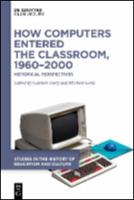How Computers Entered the Classroom, 1960–2000
Historical Perspectives
Contributor(s)
Flury, Carmen (editor)
Gleiss, Michael (editor)
Collection
DFG - German Research FoundationLanguage
EnglishAbstract
In the history of education, the question of how computers were introduced into European classrooms has so far been largely neglected. This edited volume strives to address this gap. The contributions shed light on the computerization of general education from a historical perspective, by looking closely at the different actors, political rationales and ideologies, as well as financial, political, or organizational structures and relations.
Keywords
digitalization; public education; Europe 20th centuryDOI
10.1515/9783110780147ISBN
9783110780147, 9783110779592, 9783110780284, 9783110780147Publisher
De GruyterPublisher website
https://www.degruyter.com/Publication date and place
Berlin/Boston, 2023Imprint
De Gruyter OldenbourgSeries
Studies in the History of Education and Culture / Studien zur Bildungs- und Kulturgeschichte, 2Classification
European history
History and Archaeology
20th century, c 1900 to c 1999
Later 20th century c 1950 to c 1999
Social and cultural history
History of education
Educational equipment and technology, computer-aided learning (CAL)
History of engineering and technology


 Download
Download Web Shop
Web Shop